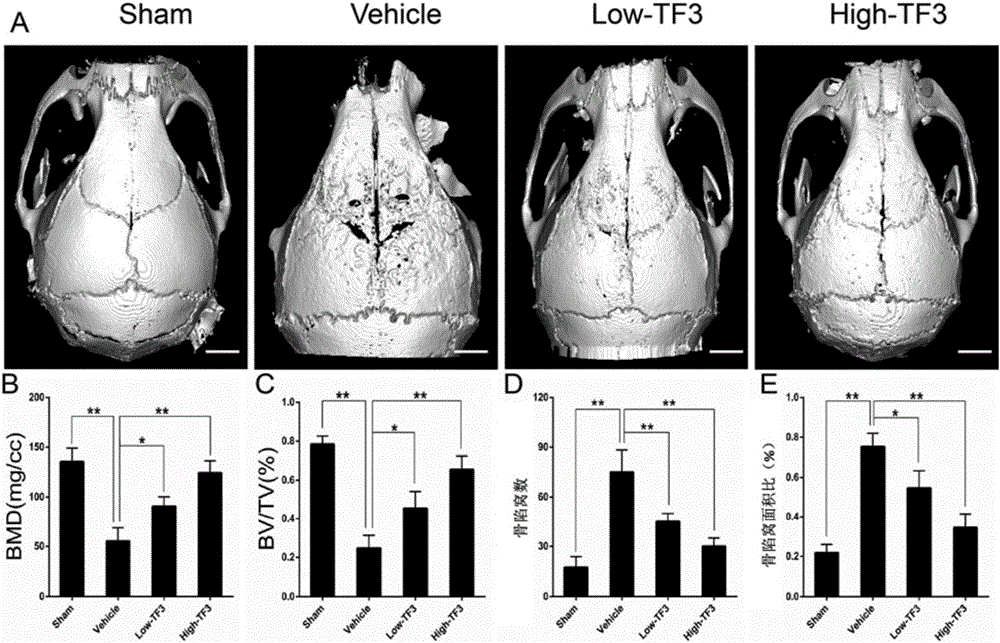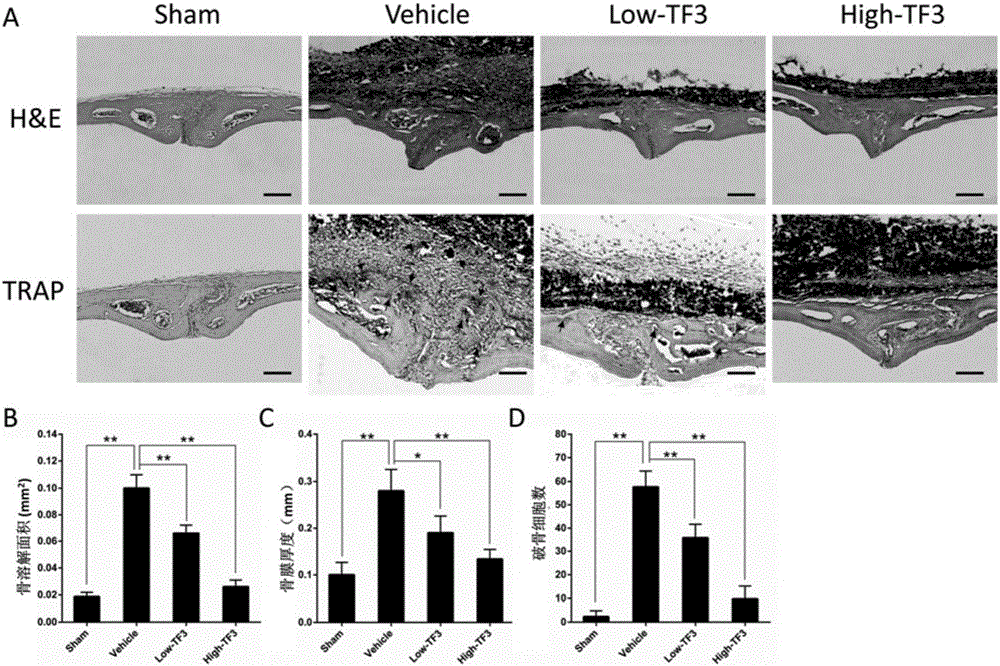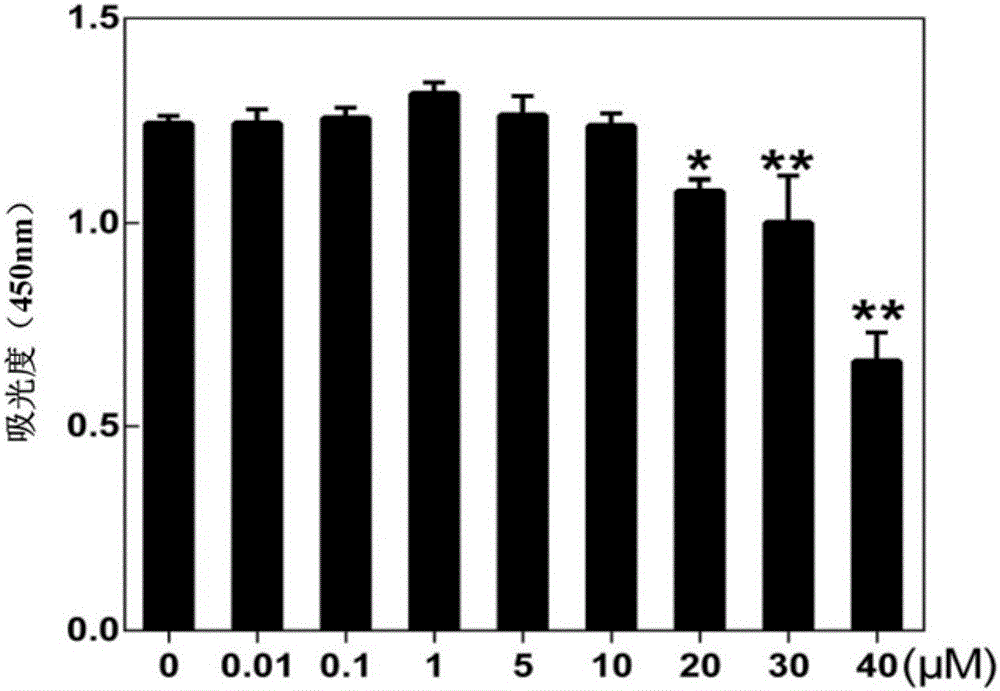Application of theaflavin-3, 3'-digallate
A bigallate and theaflavin technology is applied to medical preparations containing active ingredients, organic active ingredients, bone diseases, etc. It can solve the problem of unclear relationship between aseptic loosening of prostheses and achieve an inhibitory concentration Dependence, Effects of Lacuna Area Reduction and Bone Volume Fraction Increase
- Summary
- Abstract
- Description
- Claims
- Application Information
AI Technical Summary
Problems solved by technology
Method used
Image
Examples
Embodiment 1
[0026] Embodiment 1 establishes the application model of medicine described in the present invention
[0027] 1. Main drugs and reagents
[0028] Theaflavin-3,3'-digallate (TFDG), tartrate-resistant acid phosphatase (TRAP) staining kit, ethylenediaminetetraacetic acid disodium salt dihydrate (EDTA), and mounting medium were purchased from the United States Sigma Company; RANKL and m-CSF were purchased from American R&D Company, section paraffin was purchased from German Lecia Company, and RT-PCR kit was purchased from American Invitrogen Company.
[0029] 2. Main instruments and equipment
[0030] Micro-CT (SkyScan 1176, Belgium), paraffin slicer (Leica 2135, Germany), slicer (Leica 1120, Germany), paraffin embedding machine (BMJ-Ⅱ, Changzhou, China), upright microscope Axio Imager. M1 (Zeiss, Germany), microplate reader (Biotec, U.S.), autoclave (Sanyo, Japan), enzyme-linked immunoassay (Bio-Rad, U.S.), PCR instrument (TAKARATP800, TAKARA, Japan).
[0031] 3. Experimental ...
Embodiment 2
[0048] Example 2 Effect of TF3 on the number of lacuna, lacuna area, bone density and bone volume fraction in mouse skull
[0049] The high-resolution micro-CT SkyScan 1076 produced by Belgium SkyScan Company was used to scan and analyze the mouse skull. Remove the specimen from the fixative and allow to dry before scanning. Place each skull in a micro-CT test tube cup, 5 at a time, and separate each skull with a foam sheet; the skulls should be placed neatly to avoid touching the wall of the test tube. The scanning parameters were set as follows: scanning resolution 18 μm, rotation angle 180°, rotation angle increment 0.9°, voltage 80 kV, current 100 μA, exposure time 100 ms. After scanning, the SkyScan 1076 built-in software was used for 3D reconstruction of the skull. According to the method established by Wedemeyer (Wedemeyer C, et al. Particle-induced osteolysis in three-dimensional micro-computed tomography. Calcif Tissue Int. 2007; 81 (5): 394-402.), using CTAnalyzer ...
Embodiment 3
[0051] Example 3 Effect of TF3 on osteolysis area, periosteum thickness and number of osteoclasts in mouse skull
[0052] After the skull was decalcified with 10% EDTA, it was routinely embedded in paraffin. The skull was taken horizontally, and sliced continuously at the sagittal suture of the skull, with a thickness of 5 μm. HE and TRAP staining were performed respectively.
[0053] 1. HE staining steps
[0054] H&E staining is the most commonly used staining method. In this study, H&E staining was used to observe the general changes of the skull surface, and to analyze the degree of inflammatory cell infiltration and bone destruction. The specific operation steps are as follows:
[0055] (1) Select 5 consecutive slices for each sample, put them in an oven (60°C) and bake for 30 minutes;
[0056] (2) Paraffin sections were dewaxed with xylene (15 min×2 times), then passed through absolute ethanol, absolute ethanol, 95% ethanol, 95% ethanol, 90% ethanol, 80% ethanol, an...
PUM
| Property | Measurement | Unit |
|---|---|---|
| Diameter | aaaaa | aaaaa |
| Diameter | aaaaa | aaaaa |
| Thickness | aaaaa | aaaaa |
Abstract
Description
Claims
Application Information
 Login to View More
Login to View More - R&D Engineer
- R&D Manager
- IP Professional
- Industry Leading Data Capabilities
- Powerful AI technology
- Patent DNA Extraction
Browse by: Latest US Patents, China's latest patents, Technical Efficacy Thesaurus, Application Domain, Technology Topic, Popular Technical Reports.
© 2024 PatSnap. All rights reserved.Legal|Privacy policy|Modern Slavery Act Transparency Statement|Sitemap|About US| Contact US: help@patsnap.com










